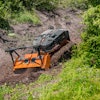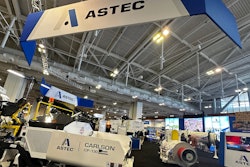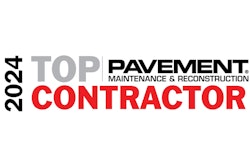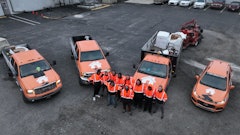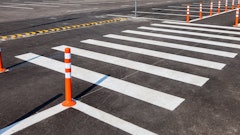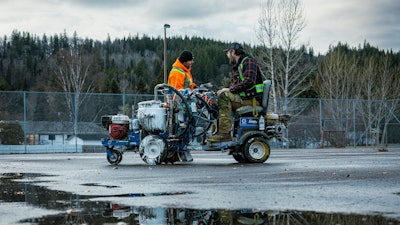
It seems like every year that goes by, the stripers are getting faster, more efficient, all while looking cooler than the year before. It’s a rapidly changing professional landscape that affords early adopters with the possibility of a competitive edge. For those striping contractors out there looking to level-up their game, what are some of the options out there, and what’s on the bleeding edge?
In The Beginning
Back in the day, if you had a freshly paved pavement surface, and a layout design for a hundred stalls, you’d have to get your measuring wheel, your chalk lines, and a calculator, to check yourself and get everything right. Now, just because this method doesn’t utilize a lot of high tech solutions, doesn’t mean it doesn’t work. It does. You can still go out there and do it this way, but it will certainly mean you’re doing things the hard way.
“If I had a one hundred stall rectangle and had to go out there by myself, right now, and do it by hand with no technology, I mean, it’s going to take me like at least three hours just to walk through it and snap all the chalk lines,” said Cam Roberts.
Roberts is the host of the Stripe-It-Up podcast, and also the owner of Laser Pavement Solutions based out of Alberta, Canada. He was, also, on a panel that I moderated at the 2023 IGNITE conference, where we discussed the future of the pavement maintenance industry. Throughout the discussion of topics that ranged from automation, mobile apps, and, of course, Artificial Intelligence, Roberts was on the side of early adopters.
“Now, the difference is, using a machine that has automatic layout technology, it’s not a stretch to say that I could do the same exact [100 stall] job in fifteen minutes,” Roberts said. That’s roughly a 1100% increase in raw efficiency, and not something that can be easily ignored.
The automation systems have the ability to measure the exact size that each stall needs to be in a given design based on the number of required stalls, versus the actual measured area. It uses an actuator tied to a solenoid wheel that measures the rotation of the wheel, and can even spray a paint marking on the surface at the exact distance that each stall width needs to be.
While these tools have been on the market awhile now, there are still plenty of contractors who haven’t adopted the them.
“Even with an automatic layout, it’s still up to you to square it up,” Mark Estrada, co-founder of Marathon Solutions Group, a Rose Paving Company, also known as Captain Striper. He spoke a few times at the recent first-ever PAVE/X, sharing tips and advice to other contractors. “It’s still up to you to find point A and point B. However, once you get comfortable with the tool, with the system, you’ll see the magic. You’re replacing a measuring tape with a calibrated laser.”
The automatic layout systems has some nuanced tricks up its sleeve that can make it very valuable. For instance, you can set up its skip mode to measure the distance between multiple stall line columns in a single parking lot, to include the needed space between them for traffic.
“You can set it up where it's spraying thirty-six feet across, and then it'll stop on thirty-six foot, and then have a twenty-foot offset for the drive lane or whatever you want it to do, it's fully programmable,” said Estrada. “Honestly, the biggest cheat-code, the biggest level-up was getting the line-driver. It boosted our production to the next level.”
“If you’re using a push behind striper, other than moving to a dual color sprayer, this will blow your mind,” Estrada continued. “The turning point for us was when we landed a massive distribution center, and we pushed through it. It was terrible. We hadn’t seen that level of high-volume striping yet. So, the next season we decided to get our first line-driver.”
There was no looking back after that. “It just changed our operations forever,” Estrada told me. “Now you cut out fatigue, increased production speed and efficiency, but, also, you just kind of make striping really fun.”
Along with another IGNITE panelist, Marco Menna of All-Out Parking Lots, Roberts and Menna shared ways in which they are already incorporating AI and looking for ways in which it can make the business more efficient.
“It’s not so much that these things will make a deciding impact today, although, they likely do,” Roberts said. “These [technologies] compound, they become more complex layer-by-layer, those guys who are getting ahead of it now will have an advantage of one kind or another going forward. It could mean the difference between getting a job and not getting a job.”
He emphasized the way that the clientele is changing as rapidly as technology, what people want and how they want it, and those who have the ability to meet those demands may have enough to earn their business when it counts.
Starting From Scratch
Obviously, if you come to work on a parking lot that had an existing layout, unless there’s a specific change requested, you’re probably going to repaint it the way it was. But what about a new parking lot? And what if it’s a weird shape or not symmetrical? All this talk about technology made me wonder, who’s deciding where and how to put the lines down in the first place? Are the contractors using a layout software? Are the thermoplastic Picassos, just painting the parking lots how they see fit?
Estrada had explained to me that you always have to find your base, set your square, but he was assuming I knew even a baseline about striping design, and that, hilariously, assumed far too much of me.
“Normally, it's working from the most important part of the parking lot. You know what the most important part of the parking lot is, right?”
I thought about it for a second, and it seemed obvious, so I said, “The entrance to the business.”
“Not just the entrance,” Estrada told me. “But the part of the parking lot that connects to the entrance, and has the ADA (Americans with Disabilities Act) compliant ramps and crosswalks from the ramp to the parking areas. Whatever you do, you must figure out where your ADA requirements are, and get those right. Then you work out from there.”
What Will Change the Game Next?
There are tech platforms, AI, and tools to make you more efficient; but what’s might be the next real game changer? Estrada, for one, believes that it could be materials based. He recently decided to get more involved using epoxy based striping material — moving away from paint or thermoplastics.
“Thermoplastics are hot-applied, and it’s only good for so many surfaces,” said Estrada. “It loves asphalt, but it hates concrete. So, we found that epoxy is just a little bit more versatile, and our minds were blown by just how durable it is.”
Epoxy has some really great additional benefits:
- It becomes embedded in the surface
- It flashes quickly
- Ground glass blend creates anti-skip surface texture
- Cool-applied, one-to-one set up machines
Versus some of the challenges that thermoplastics can present in certain scenarios:
- Hot applied, needs onsite melters
- Requires extra labor, flaggers on road jobs
- Reflective glass beads in mixture can create slipping liabilitys
“You might need anywhere from a three to five person team to run large-scale thermoplastics comfortably,” explained Estrada. “That’s not the case with the epoxy set-up, it’s all on one platform. You have a part A and a part B, and a fusion gun mixes the two, and the magic happens right there.”
In a stringent labor market, and with many employers dealing with high turnover, even all these efficiencies can require a healthy amount of time to properly train new stripers. There is a lot of nuance surrounding the work that can’t be absorbed immediately. That’s where the Estonian based company 10lines is hoping to take the striping industry into the future.
10lines offers a fully autonomous striping robot, that’s capable of taking high quality visual mapping data and a layout design software, and turning it into striping perfection. That’s the dream of it’s co-founders Janno Paas and Tarmo Prints, who already have a contractor in South Florida using the robot regularly to complete jobs.
The idea came to Jana when he was still just the owner of a small striping company. Like many places in the United States, for about five months a year in Estonia, they wouldn’t be able to work outdoors, and were forced to do jobs indoors frequently at factories.
“In these factories we saw a lot of robotics,” Said Paas. “And I imagined that surely we could get robots to paint some nice straight lines.”
With that he left the striping business directly, and worked with his business partner Prints on the concept. They started with the already established spraying technology, and build the robot around it.
“We knew if it was too small, it couldn’t carry enough paint with it, and it wouldn’t be very stable,” said Paas. “However, we wanted it to be easy enough to transport quickly from site to site.”
What they started together in 2018 has quickly advanced. The question is, how does it work?
“It doesn’t require any pre-marking or layout lines,” Paas continued. “It's all done in our software and once you go to the site, you let it loose and it will start placing the lines exactly where they have to be. In fact, the consistency of the angles and the lines, their straightness would not be achievable by a manual method.”
While you can map out what the 10lines robot will do from a photo, that is not the way to get the best results with the machine. It is best paired with an off-the-shelf drone which, paired with their proprietery software, will fly back-and-forth across the parking lot (or any designated project area) gathering high fidelty spacial data.
Once loaded into the software, it generates a digital model by stitching together all of the individual scans. It’s then with this model, using the 10lines platform on a laptop, desktop, or tablet, that the layout can be mapped.
“The program uses a drag-and-drop system, it’s very easy,” said Prints. “Once you have everything in place and you confirm it, the robot immediately sets out to complete it.”
“You can divide the job into section, and if you had multiple, they could each be assigned one section and deployed at the same time,” added Paas.
But the primary goal is to have one person with one robot, monitoring it, making changes as needed from a phone or tablet, etc. As far as efficiency stands, 10lines put it in these terms. If you had a large job that might require three workers, three days to complete, using the robot would allow one person to complete that same job in a single day. This would cut labor and work time by two-thirds. The only real need for an additional robot on site, 10lines admits, would be in a case where you might have two spraying colors, and a robot dedicated to each rather than switching colors using just one.
Their south Florida contractor already uses the robot in the field, but 10lines says that while they aren’t ready, perhaps, to ship thousands of orders, they are committed to flexibility and trying to meet the needs of the market, even while they are based in Estonia.
“We a U.S. based technicians to make sure we can provide the support,” said Prints. “We are building that network with spare parts and even spare robots if needed. We want to ensure that, even though it’s a new technology, that using it is convenient.”
Some contractors deal with high levels of turnover, under-skilled employees, lack of labor, or lack of interest in general when hunting for good workers. Exploring advances in the field could possibly lead to interesting solutions to some, or all, of these problems. The margins are getting thinner out there, and having the latest tech just might mean the difference between them.




